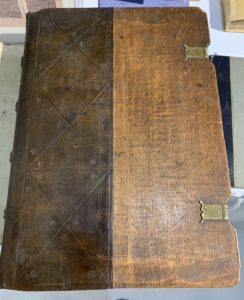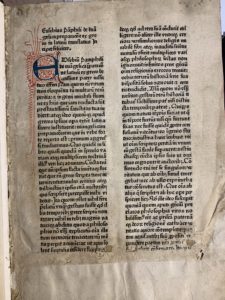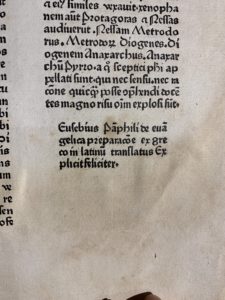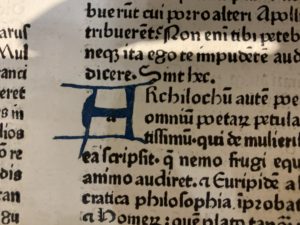March of this year, our Book Technology class visited the 2020 New York International Book Fair. Held at Park Avenue Armory, The New York International Book Fair is where booksellers from all over the world fly to NYC to exhibit and sell various rare printed materials ranging from rare books, manuscripts, ephemera, postcards, to 17th Century maps!
Being that our class studies the book as a physical object, our professor, Dr. Olivia Moy, asked us to choose an artifact and describe it as if “we are the ones selling” them. Obviously, we’re no experts, but remembering most of the things that our Book Technology class has taught us, my classmates and I were able to pull off this fun project. There were so many wonderful pieces within the fair. We saw a first edition copy of Emily Dickinson’s poetry which was selling for $5000! There were also rare editions of Stoker’s Dracula, a serialized edition of Emily Brontë’s Wuthering Heights, a signed first edition copy of Einstein’s General Theory of Relativity, as well as a signed first edition copy of Seamus Heany’s Death of a Naturalist, and so much more! It was so difficult to choose which artifact to write about, however, for some reason, I ended up writing about this obscure text which I don’t really know anything about.
This 14th Century incunabulum was written by a man named Eulebius. According to the bookseller, Mr. James Gray, the covering of the book is actually made of wood, only that half of it is covered by leather pressed with a diamond-shape pattern and flowers. The spine of the book is covered in leather as well and you can see the same floral design in between the dentelles. A metal clasp was once a part of the cover; however, it probably broke off due to poor handling.


Produced during the Hand Press Period, this folio text was written in Latin and uses a Gothic rotunda typeface. As with other older texts, the acknowledgments or the colophon as it is known to rare book aficionados, are usually found within the final page of the book. Interestingly, though the book is printed, one fascinating thing that Mr. Gray pointed out to me was how the first letter in each paragraph is actually hand-written and painted. In order for the scribe to know what letter the paragraph starts in, they would write the lower-case form of that letter at the beginning of each paragraph.



With the cover being made from wood, you can imagine that it weighs more than the average paper-back books from Barnes and Noble. As I was able to touch and feel the book, the paper really felt different from what we have today. Though not as smooth, it was thicker and felt sturdier. The ink used shows no sign of fading, it is dark and crisp and the letters are still legible. Though this 14th Century book about miracles clearly shows signs of wear and tear (water stains and some chipping in the cover), looking at it in the 21st Century, Eulebius’s book is definitely in very good condition.
Though it may seem shallow to literally judge a book by its cover, one could not help but wonder about the craftsmanship that came along the production of such text like the one above. In the age of iPhones and MacBooks, we have somehow placed a laurel upon the book for embodying virtues that we seem to think that we have left in the past, but just like an iPhone or the MacBook, the book was ground-breaking innovation in technology. An object that is assembled, marketed and consumed. Looking at Eulebius’ text, we might think that books aren’t made like that anymore. With the rise of smartphones, Nooks, eBooks, etc. the book as we know it, is dead… but is it really?






